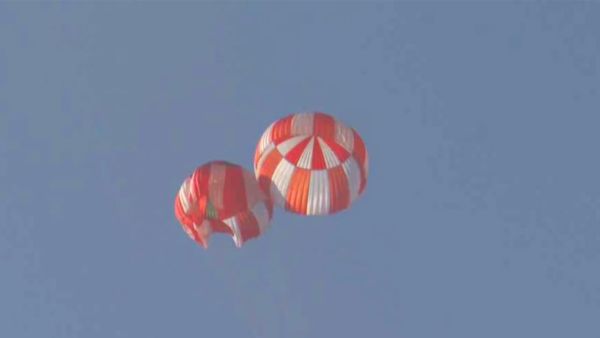
ISRO has successfully tested the Main Parachutes for its Gaganyaan Crew Module in Jhansi. The test, part of the IMAT series, validated the parachute system's design and structural integrity under a critical failure simulation.
The Indian Space Research Organisation (ISRO) has conducted a successful test of the Main Parachutes for the Gaganyaan Crew Module at the Babina Field Firing Range (BFFR), in Uttar Pradesh's Jhansi. This test, conducted on November 3, is part of the ongoing series of Integrated Main Parachute Airdrop Tests (IMAT) for the qualification of the parachute system for Gaganyaan Mission.

Gaganyaan's 10-Parachute Descent System
For the Gaganyaan Crew Module, the parachute system comprises a total of 10 parachutes of 4 types. The descent sequence begins with two apex cover separation parachutes that remove the protective cover of the parachute compartment, followed by two drogue parachutes that stabilise and decelerate the module, ISRO said in a statement on Tuesday. "Upon release of the drogues, three pilot parachutes are deployed to extract three main parachutes, which further slow down the Crew Module to ensure a safe touchdown. The system is designed with redundancy--two of the three main parachutes are sufficient to achieve a safe landing," the space organisation said.
Testing Critical Scenarios
The main parachutes of the Gaganyaan mission deploy in a step-by-step process known as reefed inflation. In this process, the parachute first opens partially, which is called reefing, and then fully opens after a predetermined period of time, known as disreefing. This process is carried out using pyro device. In this test, one of the possible extreme scenarios of delay in the disreefing between the two main parachutes was successfully demonstrated validating the main parachutes for the maximum design.
Flawless Execution and Validation
The test evaluated the system's structural integrity and load distribution under asymmetric disreefing conditions--one of the most critical load scenarios expected during actual mission descent. A simulated mass equivalent to the Crew Module was dropped from an altitude of 2.5 km using the Indian Air Force's IL-76 aircraft, as the "the parachute system deployed as planned and the sequence was executed flawlessly." The successful completion of this test marks another significant step toward qualifying the parachute system for human spaceflight, with active participation from the Vikram Sarabhai Space Centre (VSSC), ISRO, Aerial Delivery Research and Development Establishment (ADRDE), DRDO, Indian Air Force and the Indian Army. (ANI)
(Except for the headline, this story has not been edited by Asianet Newsable English staff and is published from a syndicated feed.)-
Mizoram's Traffic Management Earns National Award at UMI Conference 2025

-
Man makes rape attempt on specially-abled Bengaluru woman, arrested

-
'He Was Very Excited': Nagarjuna Recalls Ranbir Kapoor's Obsession With Shooting Animal

-
Passengers, please note: Several trains on this route have been cancelled. Check the list before your journey.

-
Dharmendra Released From Hospital; To Receive Further Treatment At Home
